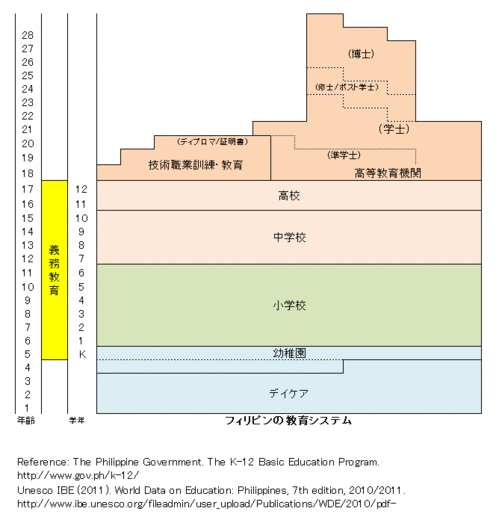| 世界の保育・幼児教育の状況を理解するために、各国の背景事情の把握は欠かせません。ここでは、その国の人口規模・教育投資などの基礎的な情報から教育制度に至るまでを、就学前の時期を中心にご紹介します。世界の保育・幼児教育に関心のある読者の皆さまの参考になれば幸いです。 |
1. 首都:マニラ
2. 人口:100 699 000 (2015)
3. 公用語:フィリピン語、英語
4. 通貨:フィリピン・ペソ(PHP)
5. 教育および保育の制度
- 学制:就学前教育(5歳)、小学校(6歳から11歳)、中学校(12歳から15歳)、高校(16歳から17歳)、高等教育(18歳から)
- 管轄省庁:ECCD協議会(0歳から4歳の乳幼児保育を管轄)、教育省 (初等中等教育を管轄)、 高等教育委員会(高等教育を管轄)、 技術教育技能開発庁 (技術職業訓練・教育を管轄)
- 義務教育:5歳から17歳
- 2011年からK-12基礎教育プログラムが始まり、幼稚園(K)への就学が義務化された。また、新たに高等学校が追加されることにより中等教育は2年延長され、10年だった義務教育が13年となった。それにともない、新システムでの高校卒業者が出る2018年から大学の一般教育カリキュラムが縮小される見込み。
- 3歳:データなし
- 4歳:データなし
- 5歳:データなし
- 6歳:データなし
- 就学前:データなし
- 初等・中等・高等教育以外の中等後教育:データなし
- 全教育段階:データなし
- 初等教育:データなし
- 就学前:データなし
- 初等教育:データなし
- PISA 2012:不参加
- TIMSS 2011(4年生):不参加

※画像をクリックすると拡大表示されます。
-
Reference 参考資料
- 2. Population Division, United Nations. World Population Prospects: The 2012 Revision.
http://esa.un.org/unpd/wpp/unpp/panel_population.htm. - 5. The Philippine Government. The K-12 Basic Education Program. http://www.gov.ph/k-12/.
- CHED. "Impact on Higher Education."
http://www.ched.gov.ph/index.php/ched-k12-transition-program/the-k12-transition-in-higher-education/. - Unesco IBE (2011). World Data on Education: Philippines, 7th edition, 2010/2011.
http://www.ibe.unesco.org/fileadmin/user_upload/Publications/WDE/2010/pdf-versions/Philippines.pdf. - 6. OECD (2014). Education at a Glance 2014: OECD Indicators, OECD Publishing.
http://dx.doi.org/10.1787/eag-2014-en. Table C2.1 Enrolment rates in early childhood and primary education, by age (2005, 2012). http://dx.doi.org/10.1787/888933118333. - 7. OECD (2014). Education at a Glance 2014: OECD Indicators, OECD Publishing.
http://dx.doi.org/10.1787/eag-2014-en. Table B4.1. Total public expenditure on education (2011). http://dx.doi.org/10.1787/888933117573. - 8. OECD (2014). Education at a Glance 2014: OECD Indicators, OECD Publishing.
http://dx.doi.org/10.1787/eag-2014-en. Table D2.1. Average class size, by type of institution and level of education (2012). http://dx.doi.org/10.1787/888933119682. - 9. OECD (2014). Education at a Glance 2014: OECD Indicators, OECD Publishing.
http://dx.doi.org/10.1787/eag-2014-en. Table D2.2. Ratio of students to teaching staff in educational institutions (2012). http://dx.doi.org/10.1787/888933119682. - 10. OECD (2013). PISA 2012 RESULTS IN FOCUS. Snapshot of performance in mathematics, reading and science. http://www.oecd.org/pisa/keyfindings/pisa-2012-results-snapshot-volume-I-ENG.pdf.
- Martin, M.O., Mullis, I.V.S., Foy, P., & Arora, A. (2012).The TIMSS 2011 International Results in Mathematics. Chestnut Hill, MA: TIMSS & PIRLS International Study Center, Boston College. http://timssandpirls.bc.edu/timss2011/downloads/T11_IR_M_Chapter1.pdf, p.40.
- Martin, M.O., Mullis, I.V.S., Foy, P., & Stanco, G.M. (2012). The TIMSS 2011 International Results in Science. Chestnut Hill, MA: TIMSS & PIRLS International Study Center, Boston College. http://timss.bc.edu/timss2011/downloads/T11_IR_S_Chapter1.pdf, p.38.














